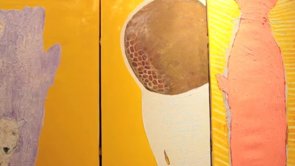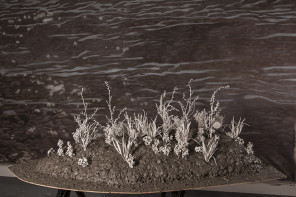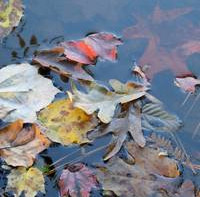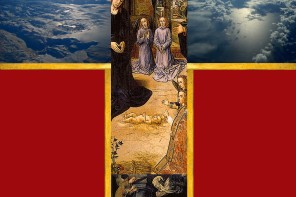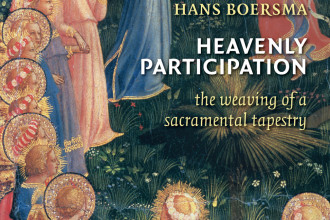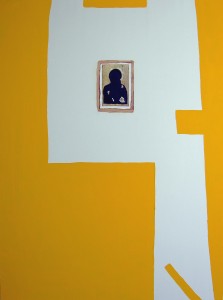
Editor’s note: This post is the fifth in a series from our “Artists in Residence,” and the second from Alfonse Borysewicz (see his first post here). Borysewicz (b. 1957) is a Brooklyn-based, American artist who, after receiving a B.A. and an M.A. from St. John’s Provincial Seminary (Detroit, MI), decided against the priesthood, moved to Boston and enrolled in the Studio School of the Museum of Fine Arts. Early success led to a string of exhibitions in Boston, New York and Tokyo, as well as two Pollock-Krasner Foundation Fellowships, and a John Simon Guggenheim Painting Fellowship. Nevertheless, Borysewicz has confessed that he was reserved about his Catholic beliefs in these early exhibitions. In the mid-nineties, however, he began to explore the biblical images which fed his imagination. This resulted in increasingly explicit religious imagery, and culminated in 2005 with four Emmanuel Paintings after which Borysewicz has moved his icons towards abstraction, “icons,” as he says, “hidden in these abstract organic forms.” This post is a reflection along these lines.
Several years ago, I happily stumbled upon (and purchased) the book In the Beginning: Bibles Before The Year 1000.[1] The mystery of the word and its exhibition in papyrus and paper invited me to reflect on my own usage of a different book; one now cut and collaged in various paintings and works on paper.
For many years there was an Icon book hanging around my studio.[2] How it got there and who brought it I don’t recall (perhaps a leftover from the previous tenant?). Ignored for a year or two, I began to scroll through it. I imagined, at times, the scene from Tarkovsky’s film The Sacrifice where the aesthete character Alexander gently turns the pages of a book of Icons given to him on his birthday. Moving, after almost 15 years, from one studio to another, I took that old book with me. With a startling few months of inertia in my new space I began to look at those Icons again. After turning the pages, however, I soon took out the scissors, cutting out some words – usually titles and dates (see “Red”) – and then later the borders, the aged frames (see “White”). It was rare that the image was used. Nevertheless there were a few successful attempts, as in “Yellow,” though the Icon was somewhat blackened out.
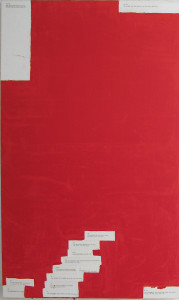

This book fed me for years, offering painting after painting and even some works on paper such as the Lumen series. For a while my studio was cluttered with leftover cut outs. I never disposed of these paper relics, just swept them into a corner for further use.
Perhaps I was consumed by what Leonard Barkan calls, in his book Mute Poetry, Speaking Pictures, “ut picture poesis,“[3] Here’s the idea: a picture contains a text or poem to be written/a poem or text gives rise to a painting or sculpture. If I read Barkan correctly, I wonder if in fact a bargain was being played out by my hand: I, the artist glorifying the iconicity of books – it’s written text and images no less – while waiting for the writer to appropriate the images I’ve made, each gathering the spoils of the other.
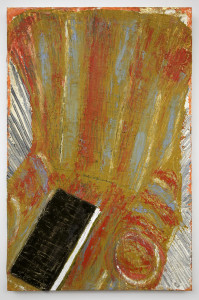
In a recent painting, “Studio Chair & Book,” I pay homage to that Icon book I tore apart for so many years in my various studios. In the painting, my cut up book is restored to its wholeness, sitting in the chair where I sat staring, absorbed by its wonders as well as the wonders I was creating. I miss that book I first ignored then embraced. I kept the unused covers as a keepsake for a time, but eventually tossed them. Farewell to that period.
Nostalgic, I get tempted, now and then, to look for another, and start anew. But I don’t think that would work. It would be staged. I would be imitating that experience with which I was once absorbed. Michael Freed speaks of this “magic of absorption,”[4] noting that “a personage entirely absorbed or engrossed in an action, feeling or state of mind is by virtue of that fact wholly unaware of anything but the object of his or her absorption … not to be ‘acting out his world, only ‘being in’ it.”[5]
“Studio Chair & Book” hangs above my bed. It will suffice until I find my next inspiration, for what is a painting if not a visual memory of a time and place, one which breathes again that same absorption when the viewer beholds?
[1] Michelle Brown, ed., In the Beginning: Bibles Before the Year 1000 (Smithsonian, 2006).
[2] Borysewicz thinks it may have been Dmitry Likhachov, Novgorod Icons: 12th – 17th Century (Aurora, 1980).
[3] Leonard Barkan, Mute Poetry, Speaking Pictures (Princeton, 2013), 4, 29.
[4] Michael Fried, Why Photography Matters as Art as Never Before (Yale University Press, 2008), 40.
[5] Fried, 47.

